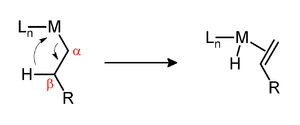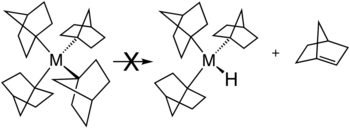beta-Hydride elimination
This article needs additional citations for verification. (August 2012) |
β-Hydride elimination is a reaction in which an
alkyl group for this reaction to occur. Moreover, for facile cleavage of the C–H bond, a d electron pair is needed for donation into the σ* orbital of the C–H bond. Thus, d0 metals alkyls are generally more stable to β-hydride elimination than d2 and higher metal alkyls and may form isolable agostic complexes, even if an empty coordination site is available.[2]

The β-hydride elimination can either be a vital step in a reaction or an unproductive
Ziegler–Natta polymerization results in polymers of decreased molecular weight. In the case of nickel- and palladium-catalyzed couplings of aryl halides with alkyl Grignard reagents, the β-hydride elimination can lower the yield. The production of branched polymers from ethylene relies on chain walking
, a key step of which is β-hydride elimination.
In some cases, β-hydride elimination is the first in a series of steps. For instance in the synthesis of RuHCl(CO)(PPh3)3 from
carbonyl (carbon monoxide
) ligand.
Avoiding β-hydride elimination
Several strategies exist for avoiding β-hydride elimination. The most common strategy is to employ alkyl ligands that do not have any hydrogen atoms at the β position. Common substituents include
neopentyl. β-Hydride elimination is also inhibited when the reaction would produce a strained alkene. This situation is illustrated by the stability of metal complexes containing norbornyl ligands, where the β-hydride elimination product would violate Bredt's rule.[3]

Bulky alkyl ligands, such as
18-electron configuration
, β-hydride elimination is not possible as well.
In some cases, the coligands can impose geometries that inhibit β-hydride elimination. For the above example, the unwanted β-hydride elimination is prevented by using a diphosphine where the two
square planar geometries, no vacant site cis to the alkyl group can be formed. Hence the β-hydride elimination is prevented. (See trans-spanning ligand
.)
References
- ISBN 978-3-527-29390-2.
- OCLC 61520528.
- .
